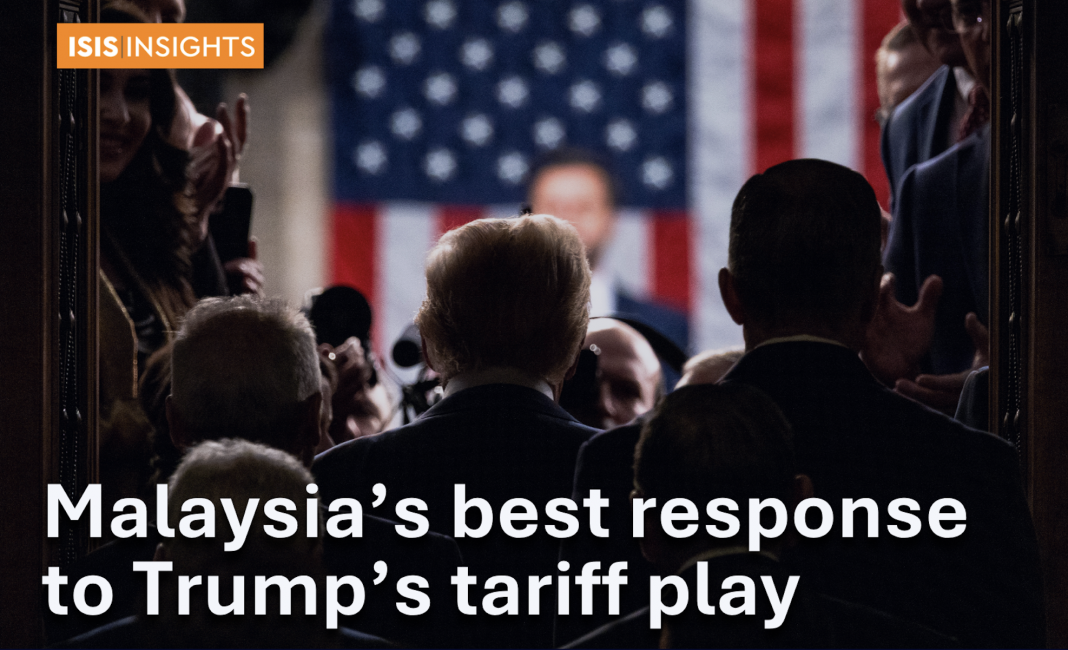Updated tariffs kick in on 1 August but Malaysia has bargaining power to secure exemptions for critical sectors.
If there was ever any doubt that US President Donald Trump’s tariffs were nothing but political, recent American actions have made this abundantly clear. Early this month, Trump announced updated duties on imports from 25 nations through a host of template letters.
Abandoning attempts to justify the tariffs using fictitious formulae, the letters talked about everything but trade. Brazil faces a 50% tariff because of Trump’s disapproval of Brasilia’s internal politics. Canada’s latest duty of 35% rests on trumped-up claims of fentanyl trafficking.
Malaysia was not spared. For no clear reason, Trump’s letter to Prime Minister Datuk Seri Anwar Ibrahim raises Malaysia’s tariff from 24% to 25%. More worryingly, the revised rate now covers “any and all” of Malaysia’s US$43 billion (RM182 billion) exports to the US.
This means critical exports like semiconductors are no longer tariff-exempt, at least unless a subsequent Truth Social post or amended executive order indicates otherwise. Previously, 45% of Malaysia’s exports to the US were explicitly excluded from Trump’s “reciprocal” tariffs, primarily in the electrical and electronics (E&E) sector.
Barring any deal, about 13% of Malaysia’s total exports will become more expensive overnight. US demand for Malaysian goods will come up against intense competition from markets subject to lower tariffs, such as the Philippines and Singapore.
Until 7 July, US-Malaysia trade talks seemed to be progressing well. Negotiations had entered their second round. Trump’s team boasted of signing “90 deals in 90 days”. So, what happened?
It is premature to conclude that the negotiations failed outright. Even close US allies like Japan and South Korea were targeted despite months at the negotiating table.
There was just not enough time for both sides to come to a reasonable agreement on the scope of trade liberalisation. Trade agreements generally take many months, if not years, to finalise.
To date, the US has yet to conclude a substantive trade deal, beyond vague framework arrangements with the UK, Vietnam and Indonesia. Trump’s latest play is to raise the stakes out of frustration with the inevitably slow pace of talks.
Malaysia has until 1 August before the updated tariffs kick in. In the meantime, Putrajaya’s priority should be to secure tariff exemptions or reductions in key sectors, including E&E.
A critical consideration is that US tariffs are likely to stay for some time. The UK, despite its bilateral trade deficit, could not push tariffs below 10%. Tariffs on Indonesia and Vietnam still hover around 20 per cent.
Rather than chasing marginal across-the-board cuts, Malaysia should focus on sectors most exposed to the US, both in dollar terms and as a share of exports. Machinery and E&E products should top the list, as they make up 55% of Malaysia’s US-bound exports.
This is more important than dismantling all our tariffs and non-tariff measures in the hopes of a hollow deal. Such an approach sets a dangerous geoeconomic precedent, leaving Malaysia vulnerable if the US reneges on any deal later.
Instead, Malaysia should address legitimate concerns in a calculated way without surrendering its policy space.
One step is to strengthen legislation against “origin washing”, or the illegal transshipment of foreign goods to circumvent US tariffs. Another is to increase imports of high-profile American products, such as aircraft and soybeans, to signal goodwill. Domestic regulations no longer serving credible public policy objectives, such as Malaysia’s 2022 ban on compliant US poultry imports, should also be revisited.
In this political game, bargaining power matters and Malaysia has it. It relies less on US import demand than Vietnam. Malaysia is also the US’ largest trading partner in semiconductor products, backed by an established ecosystem of US-led investment.
If they come to pass, semiconductor tariffs would hurt Malaysia but they would also damage the US. One example about 13,000km away shows this symbiosis in practice.
Idaho, a heavily Republican state, imports more from Malaysia than any other country. One of Idaho’s largest employers is Micron Technology, a semiconductor giant with operations in Malaysia. The company’s high-value R&D activities in Idaho complement its back-end processes in Penang and Johor.
Of course, Trump is not averse to throwing the baby out with the bathwater through self-destructive tariffs. But Malaysia could make the political costs of such tariffs clear, highlighting that Trump’s own electoral base would be in the direct line of fire.
At the same time, Malaysia must continue to diversify trade, positioning itself as a bridge between the Global South and North. Washington’s whims should not distract from the existential task of strengthening economic complexity and equitable growth at home.
There is no quick fix to the challenges that the tariffs have created. The ongoing trade realpolitik demands a strategic, nuanced response. That will serve Malaysia better than hasty concessions to a volatile partner.
This article first appeared in New Straits Times on 20 July 2025.





